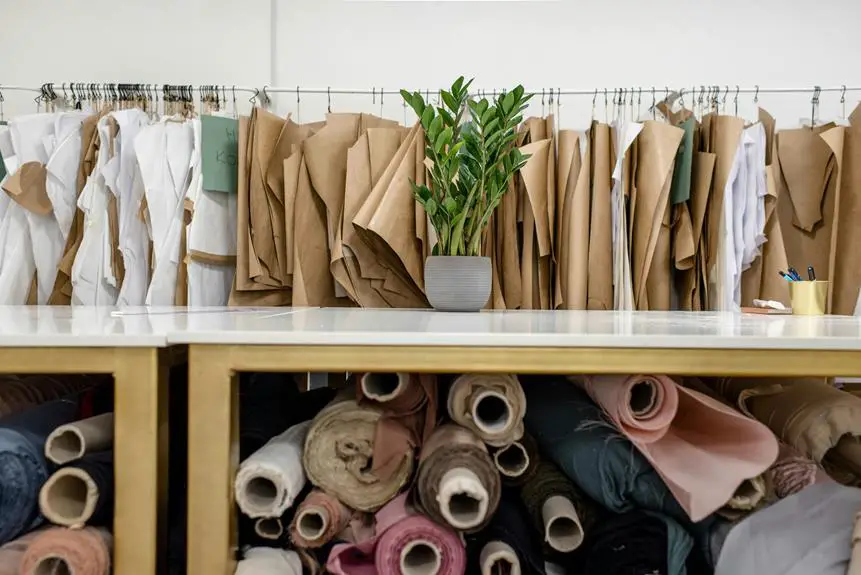When you consider the economic impact of Oxford fabric production, you might notice how it drives job creation and supports local economies. Skilled workers, from machine operators to fabric designers, play a crucial role in this sector, fostering community stability and sustainability. As global trade dynamics shift, the industry's ability to adapt becomes increasingly important. So, what does this mean for the future of textile markets and community investment? The answers could reveal unexpected opportunities and challenges ahead.
Table of Contents
Overview of Oxford Fabric
Oxford fabric is a versatile textile known for its durability and distinctive basketweave pattern, making it a popular choice for both casual and formal clothing. You'll find it in a variety of garments, from button-down shirts to dress pants, showcasing its adaptability. The fabric's unique weave not only adds texture but also enhances its strength, which means it can withstand regular wear and tear better than many other fabrics.
When you choose Oxford fabric, you're opting for a material that balances comfort with sophistication. Its breathable nature makes it suitable for different climates, allowing you to wear it year-round. Additionally, the fabric is often treated to resist wrinkles, making it ideal for those who value convenience in their wardrobe.
Oxford fabric's appeal extends beyond clothing; it's also used in accessories like bags and ties, further enhancing its versatility. As you explore options in Oxford fabric, keep in mind the various weights and finishes available, which can impact the garment's look and feel.
With its rich history and continued popularity, Oxford fabric remains a staple in the textile industry, appealing to both designers and consumers alike.
Manufacturing Processes
In the production of Oxford fabric, manufacturers typically employ a blend of traditional weaving techniques and modern machinery to achieve its signature texture and durability. This combination allows for efficient production while maintaining high quality. You'll find that the process usually begins with selecting the right blend of cotton and synthetic fibers.
Afterward, the yarn is spun and dyed, creating a vibrant palette for the fabric. The weaving stage involves using both shuttle and shuttle-less looms, which provide flexibility and speed. This ensures that the final product meets the desired specifications in terms of weight and feel.
Here's a quick overview of the key manufacturing processes:
| Process | Description | Importance |
|---|---|---|
| Yarn Spinning | Blending and spinning fibers into yarn | Forms the foundation of fabric |
| Weaving | Interlacing yarns using looms | Determines fabric structure |
| Finishing | Treatment processes to enhance texture and durability | Ensures quality and longevity |
Job Creation and Employment
The manufacturing processes involved in producing Oxford fabric not only result in high-quality textiles but also play a significant role in job creation and employment within the industry. When you consider the various stages of production—from sourcing raw materials to weaving and finishing—each step requires skilled workers. This demand for labor leads to the creation of numerous jobs, ranging from machine operators and quality control inspectors to designers and logistics personnel.
As an employer in this sector, you'll find that investing in training programs is crucial. These programs not only enhance workers' skills but also boost overall productivity, helping your business thrive. Moreover, the diverse range of positions available means that individuals with different skill sets can find employment, contributing to a more stabilized economy.
Additionally, as the demand for Oxford fabric grows, so does the potential for job growth. This expansion can lead to the development of new facilities, which further increases local employment opportunities. By prioritizing job creation, you're not only supporting your business but also fostering a robust community that benefits everyone involved.
Ultimately, the job market strengthens as Oxford fabric production continues to flourish.
Local Economic Contributions
When you consider the local economic contributions of Oxford fabric production, you'll see how it creates job opportunities and strengthens the supply chain.
It also encourages community investment initiatives that benefit everyone involved.
Let's explore how these factors come together to support the local economy.
Job Creation Opportunities
Many local communities can benefit from the job creation opportunities brought by Oxford fabric production. As demand for this versatile material increases, so does the need for skilled workers. You'll find that positions range from manufacturing to design, each contributing to the local economy.
Here's a snapshot of the job opportunities generated:
| Job Title | Skills Required | Estimated Salary |
|---|---|---|
| Textile Machine Operator | Mechanical aptitude | $30,000 – $40,000 |
| Quality Control Inspector | Attention to detail | $35,000 – $45,000 |
| Fabric Designer | Creativity, software skills | $40,000 – $60,000 |
| Production Supervisor | Leadership, experience | $50,000 – $70,000 |
Supply Chain Benefits
Supply chain benefits from Oxford fabric production significantly bolster local economies by fostering partnerships between manufacturers, suppliers, and retailers.
When you support local fabric production, you're not just buying a product; you're investing in a network that thrives on collaboration. Manufacturers rely on local suppliers for raw materials, and this creates a ripple effect, encouraging job opportunities across various sectors.
As you engage with local retailers, you help circulate revenue within your community. These retailers often choose to source locally, which not only reduces transportation costs but also minimizes environmental impact. By prioritizing local supply chains, you're contributing to a more sustainable economy that values efficiency and quality.
Moreover, the interdependence between these entities strengthens the overall economic posture of your area. When manufacturers succeed, they can reinvest in their operations, leading to innovation and further job creation.
Each link in the supply chain plays a vital role, and as you support Oxford fabric production, you're directly contributing to stability and growth in your local economy. This interconnectedness highlights the importance of conscious consumer choices that truly benefit the community you live in.
Community Investment Initiatives
How do community investment initiatives enhance local economic contributions through the production of Oxford fabric? These initiatives not only boost the local economy but also foster a sense of community pride. When businesses invest in local programs, they create a ripple effect that positively impacts everyone.
- Job Creation: You see new jobs being created, which provides more opportunities for residents.
- Skill Development: Local training programs equip you and your neighbors with valuable skills, making the workforce stronger.
- Community Engagement: These initiatives encourage you to participate in local events, fostering a sense of belonging and collaboration.
- Sustainable Growth: Investing in the community means supporting sustainable practices that benefit the environment and economy long-term.
Global Trade Dynamics
Global trade dynamics for Oxford fabric production reveal a complex interplay of demand and supply across various markets. As a stakeholder, you're likely aware that shifts in consumer preferences can significantly affect how this fabric is produced and traded globally. For instance, the rising demand for sustainable textiles has prompted manufacturers to adapt their production processes, often sourcing raw materials from eco-friendly suppliers.
You'll also notice that trade policies and tariffs can influence where Oxford fabric is produced and exported. Countries with lower labor costs may attract production, while higher tariffs can deter imports, making local production more appealing. Additionally, fluctuations in currency values can impact pricing strategies and profit margins, affecting your competitiveness in international markets.
The presence of trade agreements plays a crucial role too. They can open up new markets for Oxford fabric, allowing for greater access and potential growth. As you navigate these global dynamics, understanding regional market trends and consumer behavior will be vital.
Ultimately, staying informed will help you make strategic decisions that align with the evolving landscape of Oxford fabric production in the global marketplace.
Future Market Trends
Emerging trends in consumer preferences are set to reshape the future of Oxford fabric production, driving innovations in sustainability and design. As you navigate the evolving marketplace, you'll notice a significant shift toward eco-friendly materials and ethical manufacturing practices. This change isn't just a trend; it's a necessity for a conscious consumer base.
You'll want to keep an eye on these key trends:
- Sustainable Fabrics: Consumers increasingly demand fabrics made from recycled materials, pushing brands to innovate.
- Smart Textiles: Technology integration in textiles is rising, offering features like moisture-wicking and temperature regulation, enhancing user experience.
- Customization: Personalization is becoming more prominent, allowing consumers to design their own styles and patterns, making it a unique experience.
- Local Sourcing: Shoppers are leaning towards locally sourced materials, supporting regional economies and reducing carbon footprints.
Frequently Asked Questions
What Are the Environmental Impacts of Oxford Fabric Production?
When you consider the environmental impacts of Oxford fabric production, you'll notice issues like water pollution, energy consumption, and waste generation. You should also think about the resource depletion involved in sourcing raw materials.
How Does Oxford Fabric Compare to Other Textile Materials?
When you compare Oxford fabric to other textiles, you'll find it offers durability and versatility. Its unique weave provides strength, making it ideal for various applications, while remaining lightweight and breathable, unlike heavier materials.
What Are the Primary Uses of Oxford Fabric in Industries?
Oxford fabric's primarily used in apparel, bags, and outdoor gear. You'll find it in uniforms, backpacks, and tents due to its durability and water resistance, making it a favorite across various industries and applications.
Are There Any Health Risks Associated With Oxford Fabric Production?
Yes, there're health risks associated with oxford fabric production. Workers might be exposed to harmful chemicals during manufacturing, leading to respiratory issues or skin irritations. Proper safety measures and protective gear can help mitigate these risks.
How Can Consumers Support Sustainable Oxford Fabric Practices?
You can support sustainable Oxford fabric practices by choosing brands that prioritize eco-friendly materials, advocating for transparency in production processes, and recycling or donating old items instead of discarding them. Every small action counts!
- How Does Ring Spun Cotton Affect Garment Fit and Shape Retention? - August 13, 2024
- What Are the Challenges in Producing Ring Spun Cotton? - August 13, 2024
- Is Ring Spun Cotton Suitable for Plus-Size Clothing? - August 13, 2024






